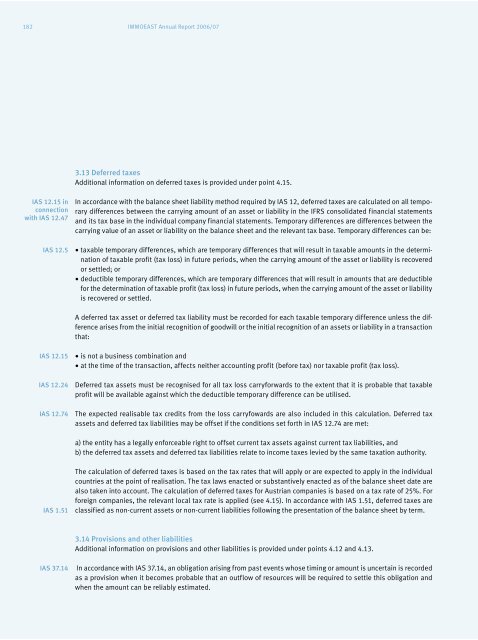IMMOEAST Annual Report 2006/07
IMMOEAST Annual Report 2006/07
IMMOEAST Annual Report 2006/07
You also want an ePaper? Increase the reach of your titles
YUMPU automatically turns print PDFs into web optimized ePapers that Google loves.
182 <strong>IMMOEAST</strong> <strong>Annual</strong> <strong>Report</strong> <strong>2006</strong>/<strong>07</strong><br />
IAS 12.15 in<br />
connection<br />
with IAS 12.47<br />
IAS 12.5<br />
IAS 12.15<br />
IAS 12.24<br />
IAS 12.74<br />
IAS 1.51<br />
IAS 37.14<br />
3.13 Deferred taxes<br />
Additional information on deferred taxes is provided under point 4.15.<br />
In accordance with the balance sheet liability method required by IAS 12, deferred taxes are calculated on all temporary<br />
differences between the carrying amount of an asset or liability in the IFRS consolidated financial statements<br />
and its tax base in the individual company financial statements. Temporary differences are differences between the<br />
carrying value of an asset or liability on the balance sheet and the relevant tax base. Temporary differences can be:<br />
• taxable temporary differences, which are temporary differences that will result in taxable amounts in the determination<br />
of taxable profit (tax loss) in future periods, when the carrying amount of the asset or liability is recovered<br />
or settled; or<br />
• deductible temporary differences, which are temporary differences that will result in amounts that are deductible<br />
for the determination of taxable profit (tax loss) in future periods, when the carrying amount of the asset or liability<br />
is recovered or settled.<br />
A deferred tax asset or deferred tax liability must be recorded for each taxable temporary difference unless the difference<br />
arises from the initial recognition of goodwill or the initial recognition of an assets or liability in a transaction<br />
that:<br />
• is not a business combination and<br />
• at the time of the transaction, affects neither accounting profit (before tax) nor taxable profit (tax loss).<br />
Deferred tax assets must be recognised for all tax loss carryforwards to the extent that it is probable that taxable<br />
profit will be available against which the deductible temporary difference can be utilised.<br />
The expected realisable tax credits from the loss carryfowards are also included in this calculation. Deferred tax<br />
assets and deferred tax liabilities may be offset if the conditions set forth in IAS 12.74 are met:<br />
a) the entity has a legally enforceable right to offset current tax assets against current tax liabilities, and<br />
b) the deferred tax assets and deferred tax liabilities relate to income taxes levied by the same taxation authority.<br />
The calculation of deferred taxes is based on the tax rates that will apply or are expected to apply in the individual<br />
countries at the point of realisation. The tax laws enacted or substantively enacted as of the balance sheet date are<br />
also taken into account. The calculation of deferred taxes for Austrian companies is based on a tax rate of 25%. For<br />
foreign companies, the relevant local tax rate is applied (see 4.15). In accordance with IAS 1.51, deferred taxes are<br />
classified as non-current assets or non-current liabilities following the presentation of the balance sheet by term.<br />
3.14 Provisions and other liabilities<br />
Additional information on provisions and other liabilities is provided under points 4.12 and 4.13.<br />
In accordance with IAS 37.14, an obligation arising from past events whose timing or amount is uncertain is recorded<br />
as a provision when it becomes probable that an outflow of resources will be required to settle this obligation and<br />
when the amount can be reliably estimated.


